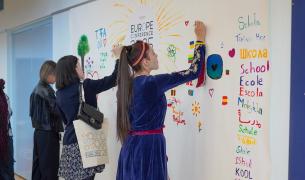How a Teacher's Head Scarf Helped Expand Her Students' World

The following is an excerpt of a story originally published on Teach For Thailand's website:
“Why are you wearing a veil? Why are you wearing a long sleeve shirt? Do the people in your country dress like this? Is your country hot?”
These are some of the questions the students at Ban Ko Rang School, Lopburi Province asked “Kru Na” (Hussana Mattapong, or “Teacher Na”), aTeach For Thailand Teaching Fellow, when they first met.
The way the students used the word “country” in their questions reflected their lack of knowledge about Islam and other religions in Thailand. It inspired Kru Na to widen her students’ perspectives by answering their questions, sharing stories and information, and asking them about their ideas and opinions. As a result, the students expanded their knowledge and learned about Muslim beliefs and customs, while Kru Na learned about Buddhist culture from her students.
As-Salaam-Alaikum is the greeting the students eagerly used to greet Kru Na after they learned about the Islamic language and culture. Despite being assigned to teach English to the class, her students’ interest in learning about Islam and other religions inspired Kru Na to share her knowledge and stories, which helped her students understand that Muslims are people who believe and practice the Islamic religion, and can also be Thais.
Religious diversity was just one example of the world’s social, cultural, and linguistic differences. Kru Na’s students asked many questions whenever they were in her English class, and as their interests grew, Kru Na used the opportunity to introduce them to more information about the world. Many students, who used to think that English was difficult, improved their learning skills.
“In addition to their lack of knowledge of other religions, some of the students had never been to the ocean,” Kru Na explained. “During the pandemic, I took the opportunity while I visited my hometown in Song Khla Province to show them the ocean while we had an online class. The students were so excited. It motivated them to be even more eager to learn new things. So I incorporated their interests into my teaching.”
Once the students began to discover more about the world, Kru Na used their engagement as a motivation to strengthen their passion for learning. When the students showed interest in Muslim culture, she added some Arabic knowledge to the class and explained the importance of foreign languages in global communication. She taught the students that the Arabic language is used in many Middle East Countries, and demonstrated some basic letters and their pronunciations to help them write their names in Arabic.
The students had fun exploring another language, which led them to feel more positively about learning English. Once they could spell and read words, they explained, English was not that difficult. The benefits of using fun to motivate the students’ interest in learning were evident in their assessments. The results clearly showed that the students at Ban Ko Rang improved their growth mindset and awareness.
Beginning with her students’ interests in religious differences, Kru Na guided her students to explore and understand the world and its diversity. Ultimately they not only learned that Muslims can also be Thais, the students viewed the world with an expanded perspective, which motivated them to change their future aspirations and set clearer educational goals.


